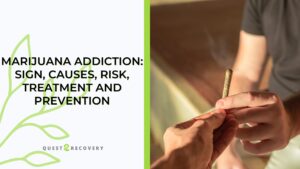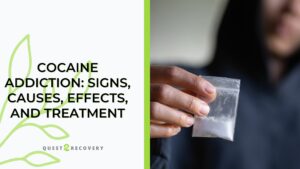Addiction is a chronic brain disorder identified by compelling substance use or dysfunctional behaviors despite the harmful effects on physical health, mental well-being, relationships, and overall quality of life.
There are two primary types of addiction – substance use disorders and behavioral addictions. Substance addictions involve drugs (such as opioids, stimulants, and alcohol). Behavioral addictions include compulsive behaviors like gambling, gaming, internet use, and shopping.
Addiction can have many effects on an individual including deteriorating health, financial struggles, legal issues, isolation, and a diminished quality of life.
To treat addictions, addicts are referred to therapy, such as cognitive-behavioral therapy (CBT), medication-assisted treatment (MAT) for substance use disorders, and support groups like Alcoholics Anonymous (AA) or Narcotics Anonymous (NA).
What are the types of Addiction?
Addiction can show in different forms, but here are its two main categories:
1. Substance Addiction
One common form of substance addiction is drug addiction. This occurs when individuals develop an irresistible need for illicit drugs or misuse prescription medications. Opioid addiction is a prevalent form of drug addiction, involving substances like heroin or prescription painkillers such as oxycodone or fentanyl.
These drugs can produce intense euphoria and lead to physical and psychological dependence. Cocaine addiction is another example, with individuals becoming addicted to the stimulating effects of the drug, which can increase energy levels and produce feelings of euphoria.
2. Behavioral Addiction
Behavioral addiction is a type of addiction characterized by the compulsive engagement in certain behaviors that provide a sense of pleasure or reward, despite negative consequences.
Most people with gambling addiction are suffering from behavioral addiction. They experience an uncontrollable urge to gamble, whether it’s through casinos, online platforms, or other forms of gambling. They struggle to control their gambling habits, leading to financial difficulties, strained relationships, and a preoccupation with gambling activities.
It’s important to recognize that behavioral addictions can vary in their manifestations and impact on individuals’ lives.

Causes of Addiction
The causes of addiction are many and can vary from person to person. Here are some common factors that may contribute to the development of addiction:
1. Genetic Factors
Having a family history of addiction can significantly increase the risk of developing an addiction. This can be due to a combination of genetic and environmental factors.
For instance, if a person has close relatives, such as parents or siblings, who struggle with addiction, they may be more likely to develop an addiction themselves.
2. Environmental Factors
Family and upbringing: Family dynamics, including parenting styles, family history of addiction, and exposure to substance abuse within the family, can contribute to the development of addiction. L
Also, people who associate with peers who engage in substance use or addictive behaviors may be more likely to experiment with those substances or behaviors themselves.
3. Psychological Factor
Addiction and mental health disorders often co-occur. Conditions such as depression, anxiety disorders, bipolar disorder, or ADHD can increase the risk of addiction. A person may turn to substances or addictive behaviors as a way to self-medicate or alleviate symptoms of their mental health condition.
Trauma and stress is also a psychological factor. Experiencing trauma, such as physical or sexual abuse, neglect, or the loss of a loved one, can increase the risk of addiction.
Note that while these factors can increase the risk of addiction, they do not guarantee that an individual will develop an addiction.
Signs of Addiction
Addiction is a progressive condition, and the longer it goes untreated, the more challenging it can become to overcome. That said, here are common signs that show you or someone close to you has an addiction:
1. Loss of Control
Individuals with addiction often experience a loss of control over their substance use or addictive behavior. They may find it difficult to limit or stop their engagement in the behavior, even when they have a strong desire to do so.
2. Increased Tolerance
Over time, individuals with addiction may develop a tolerance to the substance or behavior. This means they require more substance amounts or engage in the behavior more frequently to achieve the desired effect or reward.
3. Withdrawal Symptoms
When individuals with addiction reduce or stop their substance use or engage in addictive behavior, they may experience withdrawal symptoms. These symptoms can vary depending on the substance or behavior and may include physical discomfort, irritability, cravings, anxiety, or depression.
4. Neglecting Responsibilities
Addiction can lead to a decline in functioning in various areas of life. Individuals may neglect their responsibilities at work, school, or home. They may experience a decline in academic or occupational performance and have difficulty maintaining relationships.
5. Preoccupation and Cravings
People with addiction often have an intense preoccupation with obtaining and using the substance or engaging in addictive behavior. They may spend significant time thinking about the behavior, planning for it, or experiencing strong cravings for it.
Effects of Addiction
Addiction can have wide-ranging effects including:
- Physical health issues, including organ damage, cardiovascular problems, respiratory disorders, weakened immune system, and
- Mental health disorders such as depression, anxiety, and psychosis. Substance abuse can exacerbate existing mental health issues or contribute to the development of new ones.
- Low self-esteem or self-destructive thoughts.
- Strained relationships and breakdown of trust within families.
- Financial instability, debt, and the inability to meet basic needs.
- Social stigma and discrimination, can further isolate addicts and hinder their ability to seek help.
In other words, addiction has physical, psychological, and social consequences.
How to treat Addiction
Treating addiction requires a thorough approach that tackles the physical, psychological, and social aspects of the condition. Here is an overview of different treatment approaches commonly used for addiction:
1. Medical Interventions
Medications can play an important role in addiction treatment by managing withdrawal symptoms, reducing cravings, and addressing co-occurring mental health disorders.
For example, medications like methadone and buprenorphine are used in opioid addiction treatment, while medications like disulfiram and naltrexone are used in alcohol addiction treatment.
2. Therapy
Various therapeutic approaches like Cognitive-Behavioral Therapy (CBT) help you to identify and change negative thought patterns and behaviors associated with addiction. It focuses on developing coping skills, managing triggers, and preventing relapse.
Similarly, a therapist may introduce you to contingency management, an approach that uses positive reinforcement, such as rewards or privileges, to encourage abstinence and adherence to treatment goals.
3. Support Groups
Support groups provide individuals with community, understanding, and encouragement. One well-known example is the 12-step programs like Alcoholics Anonymous (AA) and Narcotics Anonymous (NA). These programs emphasize peer support, personal accountability, and spiritual growth.
Break Free From Addiction With Quest 2 Recovery
When developing a treatment plan, you should consider factors such as the type and severity of addiction, co-occurring mental health conditions, and personal circumstances. That way, you’re sure that the treatment is being personalized to meet the individual’s unique needs.
If you are looking to work with professionals who will offer you long-term support during your journey toward healing, then Quest 2 Recovery is your best bet! At Quest 2 Recovery, we offer evidence-based addiction treatment services including medication-assisted detox, therapy (individual, group, family, cognitive-behavioral, trauma-focused), and recreational activities.
Our experienced team provides 24/7 support, case management, and aftercare planning. Contact us today to get started!









